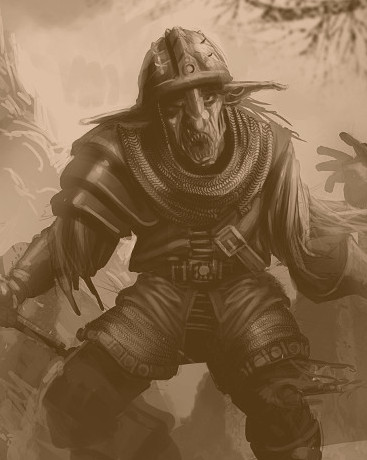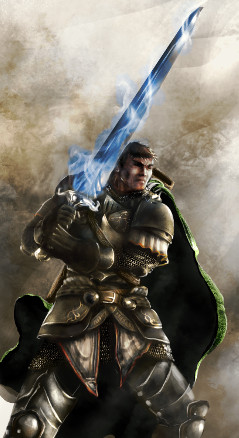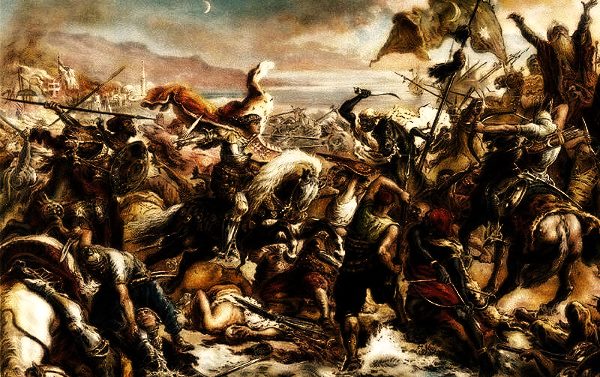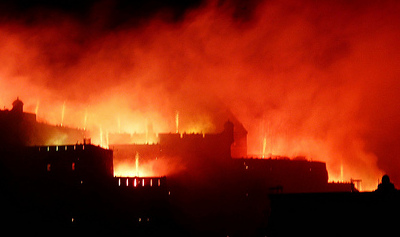Although the War of Golla and Marada had ended, some remnants of both the Maradian forces and the Gollan forces stranded on Mythania continued to fight in a senseless war for decades more.
Third Age of Darkness

By 50 CA (the Common Age), nothing remained of the former Maradian or Gollan forces. The entire world had become a lawless frontier of chaos and anarchy, terrorized by Abominations and plagued by barbarian tribes and marauding raiders.
The great cities of Marada had crumbled into ruins, and what remained of its crowning towers loomed over desolate wastelands and dark, wilderness forests. Yet, out of this darkness, new kingdoms began to arise as warring tribes united under the banner of powerful warlords and sorcerers.
Although the lands continue to be plagued by chaos and barbarians, civilization begins to rebuild. Over the next few centuries, the world population recovered to about 30 million, and within 200 years would rise to some 50 million.
The Waking of the World
Around the year 390 of the Common Age, the Archidoxy began sending scores of temple knights and missionaries from their heavily guarded monasteries to bring civilization back to Celaphania. The Stronghold of Corradon, built upon the deep ruins of Avan Corrion, establishes itself as the last bastion of civilization, ruled by a series of kings determined to bring stability and order to a world shattered by anarchy and war. Soon after, the kingdom of Armillia was founded by the legendary King Lothair, with its capital of Corradon and a sizable military force to bring peace and order to the land.
In Tarrona, the eastern kingdom of Antaria was united by King Dogart Meravan. Antaria flourished as a kingdom, but was isolated by wilderness and deserts. Early explorers began venturing out to the wildlands beyond the kingdom’s boarders, reporting strange peoples and kingdoms to the west and to the south.
Over the next 100 years, Antaria expanded from the shores of the Eastern Bay (the Bay of Antaria), eventually growing to encompass the entire eastern quarter of the continent of Tarrona. With trade and prosperity renewed, the kings of Tilsha extended their armies from Duntara to Tir Andraith and Alandar. At the same time, the people of Alandar, Velekia (later called Leleka), and central Tarrona (later called Strigovia) begin to migrate north, entering into the region of Kendes where they gradually being to displace the native Kendes tribes.
Beginning around 540 CA, a great shadow swept across the lands of Celaphania. Plagues killed thousands, insects and rats infested every home from Glaven to Relmar, and monsters prowled every corner of every duchy and barony. Mystics and seers pointed to the Azanian Jungle as the source of this despair, telling of some unspeakable evil lurking there. The heart of this dark land came to be known as the Bloodlands.
The Age of Valor

In 550 CA, the holy warrior Kalamon, Temple Knight of the Order of Arani, sets off from the Archidox to face the coming darkness. While exploring a cave in 555 CA, Kalamon had a vision that a great darkness was coming, and when he awoke, he found that he had gained the divine sword Dawnbringer. By 560 CA, Kalamon succeeded in uniting an army of Archidox temple knights and other followers, forging the mighty kingdom of Valaria with its capital, the holy city of Valaris.
By then, the malevolent Shadow of Azania had grown in power, carving out an empire of darkness. Fellspawn hordes and Abominations of every kind stormed into southern Celaphania, led by a malevolent demonic being known as Nightloch. Kalamon led his army against Nighloch and his Fellspawn hordes. In a pitched battle in the heart of the Bloodlands, Kalamon faced off with the Demon Lord himself. Although Kalamon was killed, Nightloch was vanquished and the portal to Atracus was once again sealed.
Although Valaria collapsed shortly after Kalamon’s death, the Archidoxy gained followers rapidly as the legend of Kalamon spread across Celaphania and beyond.
The Age of the Three Realms
Fueled by the rise of alchemy, magic, firearms, and clockwork machines, a new age of feudal warfare tore across Celaphania. The great kingdoms clashed in a brutal game of politics, intrigue, and warfare, known as the War of the Realms. In 780 CA, the Archidoxy succeeded in calling together the kings of the nine most powerful kingdoms and settled the War of the Realms in the Great Treaty of Valaris of 780. An uneasy peace was restored.
During this same time, in Tarrona, the kingdom of Antaria (which covered much of the eastern quarter of Tarrona) entered a halcyon of peace and prosperity. In northern Tarrona, the native tribes of Kendes have been almost entirely displaced by the people migrating from central Tarrona. The native Kendes tribes still inhabit more remote regions, but Kendes is largely controlled by those people descended from Leleka, Strigovia, or Alandar. Carsovia is also inhabited by people who have migrated over the mountains from Strigovia, but Carsovia is largely ruled by the vampiric Blood-Barons.

In 820 CA the Three Realms were effectively established when the kingdom of Armillia absorbed Camaccia, becoming the Kingdom of Celania, and the kingdoms of Provania and Delcarta unified as the Republic of Glaven. Relica, Seranosa, Crethia, and Frayor also entered a common alliance, and by 850, they had become the Regency of Relmar. During this same time, in Tarrona, the kingdom of Antaria entered a halcyon of peace and prosperity.
For the next 300 years, the Three Realms enjoyed a golden age of science, art, and discovery. The period marks the development of airships, advanced clockwork machines, and all manner of empowered devices and wondrous artifacts.
However, by the year 1220, the military might of Celania had waned; their leaders had become wealthy, gluttonous, and decadent. A series of drawn out succession wars tore Celania apart, now collectively known as the Patrician War, lasted until the outbreak of the War of Tyranny. At the same time, the Republic of Glaven and the Regency of Relmar fell into turmoil, resulting in much civil unrest and petty wars. Some foresaw a new dark age looming on the horizon.
With the glory of the Three Realms waning, a new power began to arise. First Lord Xoctlzan of the Tricarian Triumvirancy extended his power from Tricar across much of the southern Sea of Isles. In 1315, under the command of Xoctlzan’s son, Prince Zotzual, Tricarian forces seized control of Sculdora. Later that same year, his forces also seized control of the island of Nuram, securing the valuable novarite mines and refineries there. Soon after, an advanced expedition of Triclops forces took control of Arkana and Antilla as colonial annexes.
In 1320 CA, the High King of Celania was assassinated in an apparent failed conspiracy between the Patriarch of the Archidoxy and several high ranking Archidox sacredants and theocrats. What remains of the Three Realms fell into chaos. Historians later theorize that agents of the Tricarian Triumvirancy, or their secret allies, may have been behind the conspiracy.
The War of Tyranny

In the year 1322, Triclops forces stormed through southern Celaphania, launching armies and fleets from their colonial annexes in Arkana and Antilla. In less than a year, over half of southern Celaphania fell under the control of the Triumvirancy. Celania and Glaven readied for an inevitable war with the Triclopes, but with their kingdoms being mere echoes of what they once had been, the situation was bleak.
With much of Celaphania under their dominion, the Triclopes turned their attention to Tarrona, storming into Suddaea and landing ships along the coast of Tilsha. Beginning around 1323, Clovis Maradelion, the new Wielder of Dawnbringer, formed a rebellion against the Tyranny. He was soon joined by the army of Ulrick of Tilsha, Glantrus of Kaldea, and King Azzard of Suddaea.
In a bid to solidify power, Prince Zotzual’s assassinates his father, First Lord Xoctlzan, claiming control over the Triumvirancy for himself. Within days, chaos ensued throughout the royal court in Tricar, leading to more murders, arrests, plots, and conspiracies. Prince Zotzual fakes an assassination on himself and produces evidence that his sister, Princess Azuala, engineered a plot to overthrow the Triumvirancy.
In 1329, Darius, Clovis, Glantrus, and Azzard led the final push against the Triclopes armies—now aided by Princess Azuala. Princess Azuala turned much of the remaining army against Zotzual’s forces in Tricar. Zotzual’s personal guard surrenders and Azuala faces off against Prince Zotzual. After a climactic battle, Azuala kills her brother, but not before he, in his madness, sends out a psychic “kill command” to all Triclopes and their thralls. Princess Azuala survived the kill command, but thousands of Triclopes die. To her horror, she soon learns that her people had been wiped out by the telepathic suicide signal. Azuala surrenders to Darius, Clovis, and Azzard, and is presumed to have been executed.
The Rise and Fall of New Antaria
With the Tyranny overthrown, the nations of the world begin to rebuild. At the same time, barbarism and chaos were also on the rise. In Celaphania, political turmoil and conflicts between feuding lords over various successions and territories continued to escalate. There were countless “minor wars” between nobles, especially in Glaven, which came to be ruled by powerful merchant houses.
Around this same time, an alliance begins to form between nations of northern Tarrona. These include the nations of Kendes, Carsovia, Tir Scaith, and Kaldea—the so-called “Dark Kingdoms.” The expansion of Kendes, Carsovia, and Kaldea through northern Tarrona alarmed many, but their expansion fell short of the Antarian border. Even so, skirmishes between Kaldea and Antaria along the Vestulga River only escalated as tension between the nations continued to rise. Kaldean piracy also became a major problem. Having scarce natural resources and little arable land, Kendes began to build foundries and factories to produce raw materials and goods.

In 1380, with support from Kendes, Kaldean forces lead by Glantrus the Immortal, Wielder of Soulreaper, invaded northern Antaria. Although he was encouraged to flee, the elderly King Clovis donned his armor and took his mighty sword Dawnbringer to stand against the onslaught. In an explosion so great “it seemed the sun had descended upon the earth,” the invading armies were obliterated. King Clovis’s body was never found, and Dawnbringer had again vanished from the face of the earth. With their own leader lost to battle, the Kaldean armies withdrew back to its northern lands.
Following the death of Clovis, Antaria collapsed into chaos within a matter of years. The Baronies of Ambricar were all that remained of the once unified kingdom of Antaria, thanks chiefly to the establishment of the baronial council in Eddonkeep in Tareneth. To their north, the region between Kaldea and Ambricar came to be known as the Ruined Lands.
The Age of Progress
The modern age, generally known as the Age of Progress, began around 1400 CA. Great technological advances continued during this period, leading to the widespread use of steam-power, airships, and aeronefs, while new discoveries in alchemy, medicine, and engineering elevated civilization to heights not seen since the Age of Marada.

Between 1450 and 1530 CA, further developments in aeronautics, mechanics, and manufacturing heralded extraordinary new inventions. Locomotive engines thundered across vast distances, hauling trains of box cars and passengers to far-away destinations. Mighty aircruisers plowed through cloud-veiled skies, and burgeoning new manufactories brought jobs to the thousands who flocked to the cities in search of new dreams and new opportunities.
At the same time, the highly industrialized nation of Kendes, under the rule of their ruthless Tzarahad, made even greater strides in the fields of alchemy, thaumaturgy, and aetheric over-science. There, in the heart of the Dark Kingdoms, the Age of Progress became a nightmare of sorcerous evil and urban decay. Alchemical horrors and monstrous war machines brought terror and destruction upon all who opposed the Tzarahad’s tyrannical regime. While the great and powerful luxuriated in the decadence of unimaginable wealth, the starving masses howled beneath the crushing wheel of unrelenting industry.
The Rise of the Grand Imperium
In the late 1490s, the warlord Malkavek Ŝangsyer solidified his military and political control over Kendes. In his rise to become the new Tzarahad, Ŝangsyer saw to the brutal extermination of all other noble houses that could challenge his right to the Raven Throne. Led by the new Tzarahad and the governing body, the Samaara Hadrahan, Kendes grew to become a mighty kingdom of industry and sorcery. Kalkhemed, the capital of Kendes, grew into a vast city of manufactories, reaching black towers, enormous shipyards, and ever-turning ironworks. Their technology rivaled, and perhaps even surprised, that of the Commonwealth and even Armillia, and their military might expanded with every passing year.

In the late 1520s and early 1530s, war-mongering factions within the Samaara Hadrahan pressed for an invasion of Leleka to “retake” the region of Phana (then held by Strigovia) which had once belonged to Tir Scaith. Drunk with power and eager to relive the glories of his youth, the Tzarahad committed the Grand Imperium’s vast military and industrial resources to the new war effort.
In 1532, Leleka and parts of the northern Moytura region of Strigovia were annexed into the Grand Imperium—Leleka willingly (likely under duress), and northern Stragovia through invasion. Soon after, in 1533 and 1534, the Kaldean army invaded the Ruined Lands north of the Baronies of Ambricar to reclaim territories once held by Kaldea.
So began the War of Wars.
